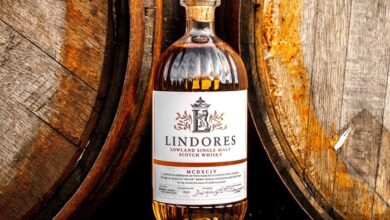Bourbon, Scotch, and the Port Finish
By Richard Thomas

(Credit: Richard Thomas)
As the practice of finishing whiskey in used barrels spreads from Scotland to the United States, the use of old Port barrels in particular has become the heart of the now shared practice. Although scotch has been both aged and finished in a variety of used barrels as a matter of routine for many years, and some recently released American whiskey has been finished in old rum barrels and red wine casks, it’s the Port barrel finish that has gained real traction on both sides of the Atlantic. Angel’s Envy is only the best known of a group of new bourbons that has taken its place among the fine, Port-finished whiskeys produced by Scottish distilleries such as GlenDronach, and big Scotch blended whiskey companies such as Grant’s and Famous Grouse.
Why That Douro Polish?
The reasons why a whiskey-maker might reach for old Port casks are as varied as Port wine itself. Made exclusively from wine grapes in the Douro Valley of Portugal, Port is wine fortified with aguardente, a neutral grape spirit. Although it sounds simple, Port has a wide, deep variety of expressions, some matured in wood and some aged in the bottle. Even within just the wood-aged Port that is relevant to whiskey finishing, there is a rich and diverse flavor profile, giving a whiskey-maker considerable flexibility in meeting his ends.
Sometimes the intent of the Port finish is limited in nature, as is the case with Angel’s Envy bourbon, which is finished in Port barrels for only three to six months. “We only wanted [the] Port to soften the overall bourbon character and not to drive the overall flavor” says Lincoln Henderson, Angel Envy’s Master Distiller.
Likewise, Grant’s Whisky looks at the Port-finish of their 18 Year Old blended scotch as being just part of the blending process. “It is more of a marrying period in ex-Port wood rather than a straight forward finish” says Grant’s master blender Brian Kinsman. ” The delicate uptake of flavour from the Portuguese oak happens at the same time as the different malt and grain whiskies.”
Taking the opposite approach are Scotland’s BenRiach and GlenDronach. Describing his 1st Edition Solstice 15 Year Old, Brand Ambassador and former distillery manager Stewart Buchanan said “The objective was to get the biggest influence of the sweet fruity notes of the ruby [Port] to balance seamlessly with the levels of the phenols in the whisky, without over powering the more delicate barley note which Benriach characteristically has.” Reflecting that commitment to getting the most out of the Port wood, that Solstice scotch to spent 3 1/2 years in a trio of gigantic, 158.5 gallon (600 liter) ruby Port barrels, or “pipes.”
In between these poles lies a distillery like the Balvenie, where a granddaddy of Port-finished whiskey is made in the form of its 21 Year Old Portwood. ““The 21yo Balvenie is already rich honeyed and slightly oaky,” says the Balvenie’s master blender David Stewart, “but the Port does add more sweetness and a winey richness. The Balvenie and the Old Tawny Port combination seems to work and does produce a wonderful single malt.”
Port Wood
When you ask most whiskey-makers where they get their wood from, the answer is sometimes evasive, and old Port barrels are no exception. No one I spoke to was willing to reveal what Port wine house supplies their barrels, but the emphasis on type was wood-aged ruby casks rather than tawny casks.
Another common feature when it came to wood was the lack of interest in drawing anything from the oak itself. The point of finishing in a Port barrel is to make use of the grape impregnated into the wood, which has few remaining oak qualities after spending anywhere from several years to three decades aging Port in the first place.
Sometimes that grape essence is so intense that the barrel is used over and over again. Grant’s draws on barrels ranging from first-fill to several fills later, and balances the results to achieve the desired flavor profile. The Balvenie relies on first-fill Port barrels for its 21 Year Portwood, but says that doesn’t mean the barrels won’t be used again on down the line for some other product.
Whiskey-makers also want their Port barrels intact. Unlike with spirits-makers in other sectors, who sometimes rebuild their used barrels, few if any whiskey-makers use this practice. Angel’s Envy indicated they had their barrels shrink-wrapped before shipment to the United States, “to keep the barrel in top shape.”
Matching Whiskey to Wood
Picking the right Port wood is only part of the process, as selecting the right whiskey match the Port finish is just as important. I’ve sampled some experimental port-finished bourbon in my time that ranged from unremarkable to wretched, and the choice of bourbon likely had as much or more to do with that as the Port wood.
Although Angel’s Envy and some other American bourbon-maker’s who have gotten into the practice of Port-finishing are secretive about their whiskey sourcing, over in Scotland whiskey-makers are more talkative about what they are looking for. The difference might be because their scotch comes largely or entirely comes from in-house sources, whereas most of the Port-finished bourbon in the United States is supplied by second parties.

(Credit: Angel’s Envy)
“We want to find the most robust and spicy casks which we will know will handle the rich port notes,” says BenRiach’s Buchanan. “Especially when working with peat we want those to be as high in phenols as possible.”
“As long as the whisky is well matured and been matured in American Oak casks,” says the Balvenie’s Stewart, “then I think most ages from about 12 years old would work well with Port.”
Grant’s Kinsman reports “The whisky needs to be quite full bodied in its own right: rich, sweet, oaky and full of tannin flavors.”
An Appreciation for Port?
As a Bluegrass-born whiskey drinker with marital ties to Portugal, I believe my familiarity with Portugal’s most famous wine only enhances my appreciation for Port-finished whiskey. Whenever I unstop a new bottle of the stuff, I always like to think that something of my life’s story is represented in that bottle of port-finished whiskey. However, I know that level of appreciation isn’t shared by many whiskey-drinkers. I’ve spoken to enough Angel’s Envy fans and people at scotch events to know how few have ever had a glass of Port, let alone drink it frequently.
For whiskey-makers, however, at least a passing familiarity with Port seems a prerequisite for practicing the Port finish. Most pursuing this method are familiar enough with Port to name a favorite type, and some love the stuff. “I’m known for having rather a sweet tooth,” says Stewart Buchanan, “so normally I love a big rounded, robust and fruity ruby style but as a special treat to myself will on occasion sit back with something that has more complexity in the tawny/vintage style. In port drinking, I see great similarities with single malt.”
“I like LBV ports” says Brian Kinsman. ” I don’t have a particular brand I drink as I like to try them all to explore the different flavors.”
Among whiskey-lovers, it seems enjoying a good Port-finish doesn’t necessarily lead to crossing over and taking an interest in Port itself. In the end that might not matter, because the whiskey’s maker goes there for them.



Very informative. I might need to check that BenRiach/GlenDronach stuff. Time to go look up prices…
Balvenie’s 21YO sounds great too, but I bet its way out of my budget.